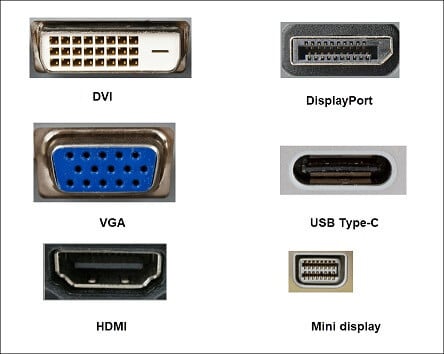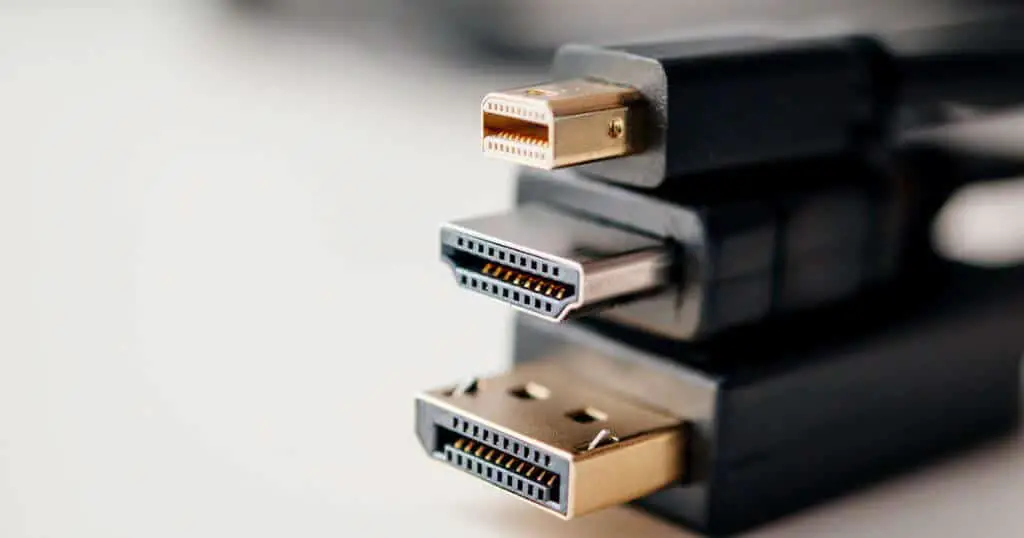Nowadays, there are different types of connections for monitors — each one serving a specific purpose. Each one of these connections has its respective features, advantages, and of course, disadvantages.
Currently, there are six popular types of connections for monitors. They are:
- HDMI (High Definition Multimedia Interface)
- DVI (Digital Visual Interface)
- VGA (Video Graphics Array)
- DisplayPort
- SDI (Serial Digital Interface)
- USB Connection
As a computer user, it’s in your best interest to understand the different types of connections available for your monitor. With this level of understanding, you can choose the right connection type for a given situation.
Let’s explore each one!
At Office Solution Pro, we are passionate about Ergonomics! Our readers support the page. If you click on a link, we may earn a small commission at no cost to you. We hope you love the products we recommend as much as we do!
Different Types of Connections for Monitors
| HDMI | DVI | VGA | DisplayPort | SDI | USB |
|---|---|---|---|---|---|

Best for TV to PC | 
144Hz at 1080p | 
Old, legacy video connector | 
Transmits 144Hz up to 4K | 
Delivery of digital video | 
Best for laptops and mobile |

1. HDMI (High Definition Multimedia Interface)
HDMI is an acronym for High Definition Multimedia Interface. An HDMI connection has the fundamental goal of displaying media, such as videos, in high resolutions.
Of all the different types of connections for monitors, HDMI is earmarked as the best for audio and visual content. When you play media on a monitor via an HDMI connection, the result is outstanding audio and video quality.
Because of the quality of its display, the HDMI cable is a popular monitor connection. HDMI has quickly become the standard for third-party display in corporate and domestic situations.
Today, every monitor manufacturer builds their monitors with an HDMI connection port. The HDMI connection port is also available on other multimedia devices like an Xbox, projectors, PlayStation, and even some mobile phones.
There are different types of HDMI connections for monitors. We can group HDMI connections based on the features and size of the connection.
Types of HDMI Connections by Features
Using the features as a reference point, here are the different types of HDMI connections:
1. Standard HDMI
This is arguably the most common HDMI port and cable connection. Standard HDMI will give you a display quality of 720p or 1080p. If you need high-quality pictures on your monitor, Standard HDMI isn’t the right monitor connection. Some standard HDMI ports come with an ethernet network feature.
2. High-Speed HDMI
This type of HDMI is the right fit if you want a 4K resolution display on your monitor.
3. HDMI Premium High-Speed
If your device has the HDR feature, this is the type of HDMI connection to use with your monitor.
4. HDMI 2.1
This type of HDMI connection was launched in 2017 and is designed for high-quality multimedia display. With HDMI 2.1, you can transfer data at a speed of 100 mbit/s, even with 8k resolution videos.
It also works at a frequency of 165 Hertz. Because it works at such a high frequency, experts sometimes describe it as HDMI ultra-high speed.
Types of HDMI Connections by Size
You can connect many devices to your monitor using an HDMI connection. Since these devices come in different sizes, it’s only normal that HDMI connections come in different sizes.
Based on the size, the different types of HDMI connections for monitors are:
1. Type A
This HDMI connector has 19 pins inside. The dimension outside is 1.39cm by 0.445cm, while the inner dimension is 1.4cm by 0.445cm.
2. Type B
There are 29 pins inside the type B HDMI connector. The dimensions of the type B connection are 2.92cm by 0.445cm.
3. Type C
The type C HDMI connector has a lot of similarities with the type A connector. Like the type A HDMI, it has 19 pins inside. The primary difference is the size, with type C having a dimension of 1.042cm by 0.242cm. You can still use the type A and type C HDMI interchangeably if you have a type A to type C cable.
4. Type D
Type D HDMI has the smallest size. Also called the micro HDMI, it has 19 pins inside and was first launched with HDMI 1.4. The dimensions of this HDMI connection are 0.64cm by 0.28cm.
5. Type E
Like the type D HDMI, the Type E HDMI launched alongside HDMI 1.4. Within Type E HDMI, there’s a relay connector that fosters the connection.
2. DVI (Digital Visual Interface)
DVI is a short form for Digital Visual Interface. Before HDMI became the most popular of the different types of connections for monitors, DVI was the order of the day.
Launched in 1999, DVI grew popular because of its fantastic video display. Most people to date love to use the digital visual interface for videos on an LCD monitor.
The DVI can transmit both digital and analog data to an LCD screen. A DVI port has a striking resemblance with that of VGA, which is why users may mistake both connections for each other. However, if you take a closer look at the flat pins of DVI, you’ll notice they’re longer than that of the VGA.
There are three types of DVI connections: DVI-D, DVI-A, and DVI-I.
1. DVI-D
Firstly, the second “D” in DVI-D stands for digital. This type of DVI port works primarily with digital signals alone. In total, you have 24 pins in a DVI-D port evenly divided into three equal rows.
If you want to use a DVI-D port on your monitor, you have no option but to get a DVI-D cable. The DVI-D cable works by reading the signal digitally from the source to the LCD monitor. Here’s how it works:
- The DVI-D compresses the signals from the video with a video card
- It has a VGA output to convert the video into its analog form
- When the analog signal transmits to the monitor, it converts into a digital signal
There are two major types of DVI-D connectors — the single-link and the dual-link. The dual-link DVI-D connector is described above. For the single-link DVI-D, the difference is in the pin arrangement. The single-link DVI-D has 18 pins divided into two halves.
2. DVI-A
The “A” in DVI-A stands for analog. DVI-A works well with only analog signals. There are four major pins arranged with 12 others, all-around a single pin. In total, the number of pins present in a DVI-A connection port is 17.
The best video quality you’ll get with this connection will have a resolution of 1920 by 1080. Today, it may be challenging to find a monitor that supports DVI-A connections.
3. DVI-I
The “I” in the DVI-I stands for integrated. As the name implies, it’s the variation of DVI which integrates both analog and digital functions. There are two types of DVI-I, namely single-link and dual-link. If your monitor has a DVI-I port, it can work with either a DVI-D or DVI-A connection.
3. VGA (Video Graphics Array)
Of all the different types of connections for monitors, the VGA is the oldest. In fact, the VGA port has been in existence since 1987.
When it first launched, the VGA connection grew popular because of its efficiency. But the advent of different types of connections for monitors means the VGA port has lost value and popularity. Most people use VGA ports today to connect their old computers to a new pc.
VGA is an acronym for Video Graphics Array, and of course, its primary use is to transfer video signals. The VGA port reads signals electronically from the source before displaying media on the monitor. VGA ports only work perfectly for analog signals.
One advantage VGA ports have over the different types of connections for monitors is their widespread use. Because VGA ports have existed for a long time, almost every computer comes with VGA installed.
You don’t need to go through the rigor of installing a driver before you use the VGA port. All you’ll need is a compatible VGA cable.
The best way to identify a VGA port is through the pins inside the port and cable. Typically, you should see between 14 and 15 pins inside a VGA port.
If you’re looking to display videos at a high resolution, the VGA port may not exactly be your best option. However, there is a variation of VGA known as SVGA, which has a better video display quality.
SVGA stands for Super Video Graphics Array and it has better video display qualities compared to VGA.
4. DisplayPort
The DisplayPort is one of the recently created types of connections for monitors. The DisplayPort connection came into the market scene in the late 2000s. But amongst all the different types of connections for monitors, the DisplayPort still ranks top in display quality.

You can easily trace the quality of DisplayPort to the fact that it’s a recent development. It’s not as common as the other types of monitor connections. You may only see a DisplayPort on a monitor with specific functions.
If you’re a video editor, motion graphics designer or gamer, you’ll like the quality of the video display that a DisplayPort connection offers.
The DisplayPort comes with a USB connection in most cases, so you don’t need to get another USB cable. Also, you can use a DisplayPort with other monitor connectors like VGA, HDMI, among others.
Types of DisplayPort
There are four major types of DisplayPort in use today.
- DisplayPort 1.2: This type of DisplayPort will work perfectly if your monitor’s resolution is 3460 by 2160. The video quality should be 4K, and the frequency rate should be about 60Hz.
- DisplayPort 1.3: This variation of DisplayPort will work well when your video quality is 8k, and your frequency is 30Hz. A significant advantage of this DisplayPort variation is its workability with the newer graphic cards.
- DisplayPort 1.4: If you’re a game lover, you should look to work with this variation of DisplayPort. It works with HDR videos, 8K video quality, and a frequency of 60Hz.
- Mini DisplayPort: As you can already guess, this is a DisplayPort with a small size. It is a variation of DisplayPort that works perfectly with Apple devices. You can configure the mini DisplayPort to work with HDMI, VGA, and DVI and it’ll produce good image quality.
5. SDI (Serial Digital Interface)
SDI is an acronym for Serial Digital Interface. It’s part of a class of video interfaces used for motion pictures.
On a monitor, an SDI port has a solitary pin connection with the capability to transmit unencrypted and uncompressed digital signals.
Of the different types of connections for monitors, SDI has the highest range. It works with a coaxial cable that can function over distances up to 300 meters without a loss in signal strength. Digital connections on SDI use a designated BNC connector. It’s popular for connecting security cameras to monitors.
6. USB Connection
Of course, you’ll know your computer has a USB port, but you may not know you can use it to connect to other screens. USB is a short form for Universal Serial Bus.
Today, many use their USB ports to connect to devices like cameras, phones, and external storage systems. You can use a USB connection to connect to secondary display devices. This characteristic sometimes goes under the radar, but it makes USB one of the different types of connections for monitors.
Compared to the other options on this list, USB is not the best fit for displaying media on a monitor. USB connections offer a limited resolution. The display on your monitor won’t get better than 1024 x 768.
When using a USB connection for monitors, you can choose from any of these available options:
- USB 2.0 type A
- Micro USB
- USB 3.0 types A and B
- Mini and micro USB
- USB-C
Thunderbolt is another type of connection for monitors which stylishly falls under the USB family. It has 24 pins within it and uses a USB type C connection. It has the fastest USB transfer speed available. A thunderbolt USB can transfer data at speeds of 10 gigabytes per second.
You may also want to read:
Final Thoughts
If you need another display, there are different types of connections for your monitors. It’s left for you to choose the best option for your computer. The right choice of connection will depend on the functionality you want. In some other cases, the best choice may depend on the video source or final display device.
Above, we have explained six types of connections you can use for your monitors. With the information above, you can choose the best type of connection to fit your specific needs. Good luck!












